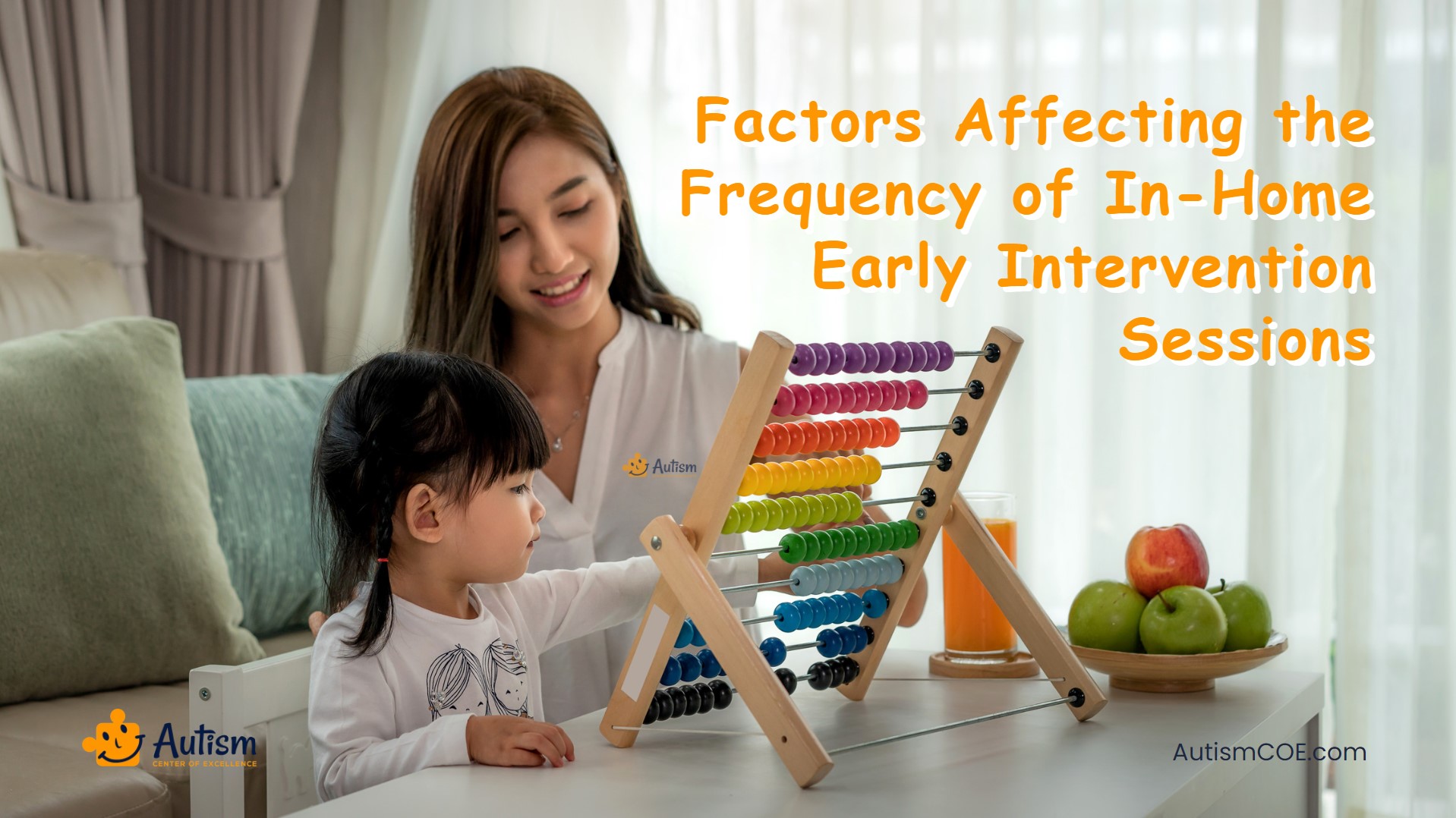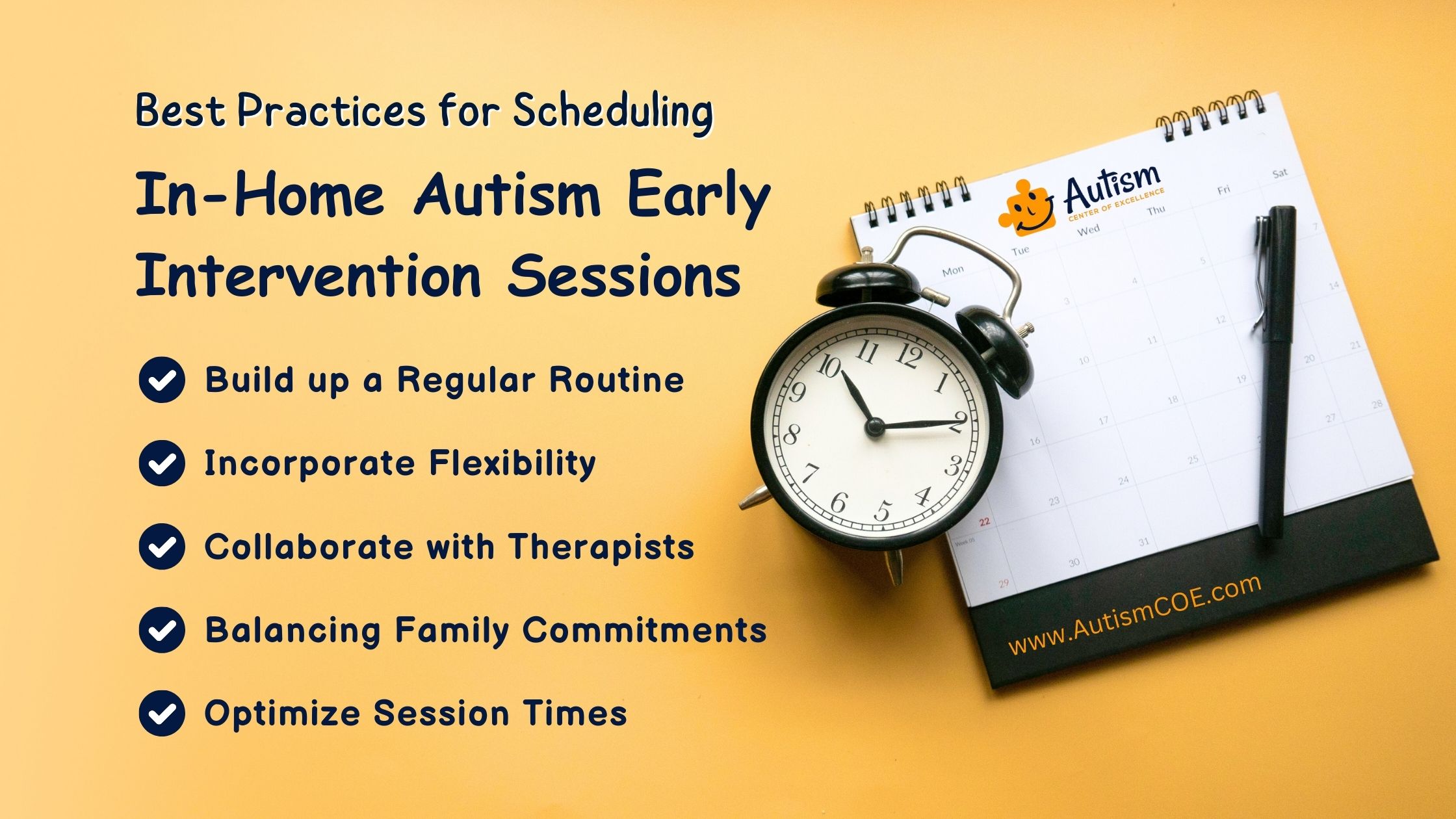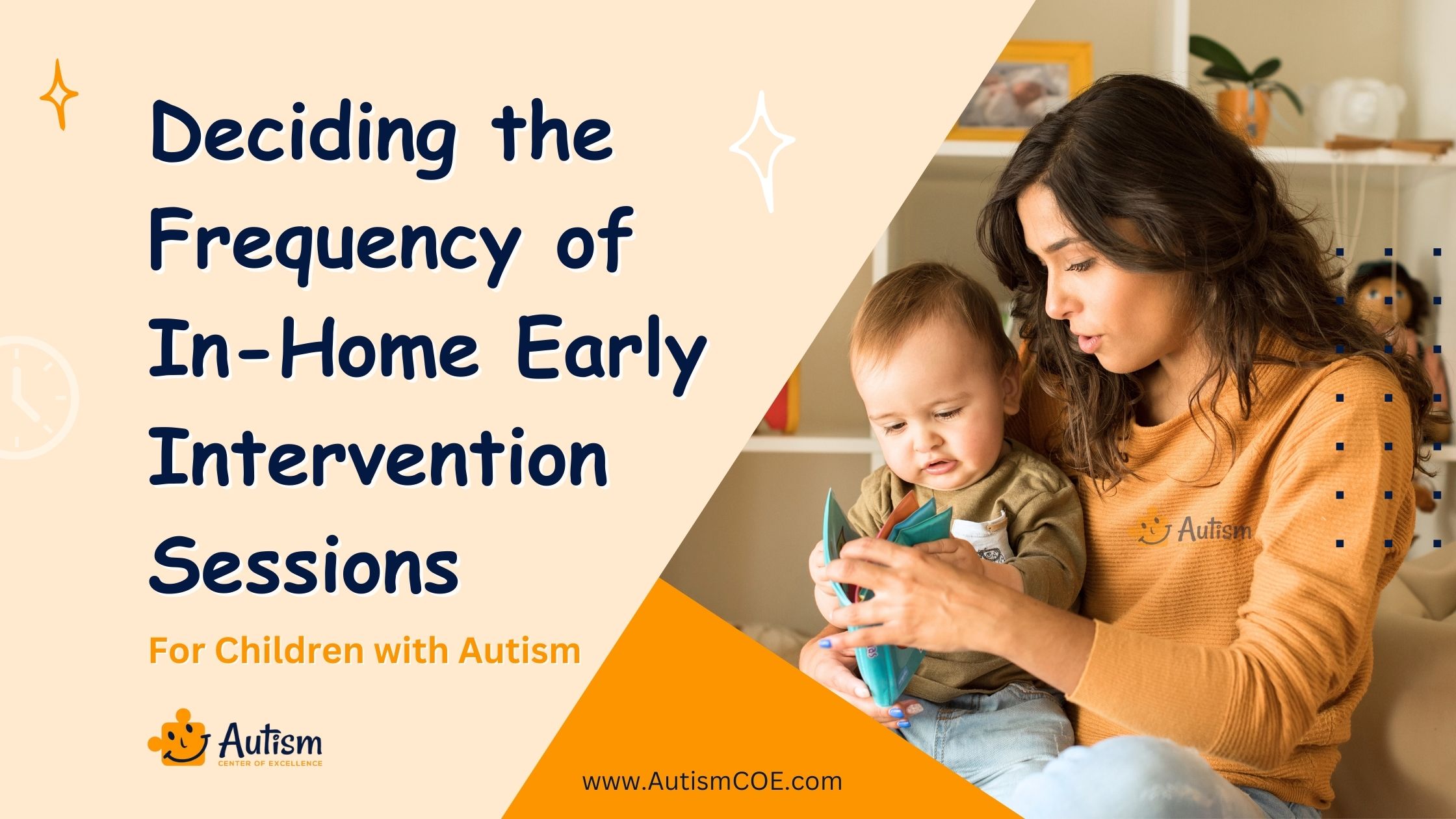The right frequency for In-Home Early Intervention sessions is one of the most vital decisions a parent or caregiver will make for the progress of a child with autism. These sessions offer support and strategies created especially for your child’s needs, making a great difference in their child’s development and developmental outcomes.
These sessions can vary in frequency for several reasons, which we will discuss below in this blog. Collaborating with a therapist or professional can aid in developing a personalized schedule, leveraging early intervention to ensure your child receives consistent and valuable support aligned with their growth and learning pace.
In this blog post, we will explore the factors affecting session frequency and best practices for scheduling. We’ll also address common questions to guide you through this crucial part of your child’s therapy journey.
Understanding Early Intervention Services
Early intervention services are designed to support the development of young children with disabilities or developmental delays. These services are typically provided by a team of professionals, including therapists, educators, and social workers, who work together to create a personalized plan for each child. The goal is to address various aspects of a child’s development, such as physical, cognitive, communication, social, and emotional skills, to help them reach their full potential.
Early intervention services are crucial because they leverage the critical early years of a child’s life when their brain is most adaptable and capable of significant growth. By providing targeted support and interventions during this period, early intervention programs can make a substantial difference in a child’s developmental trajectory.
Impact of Early Intervention Services Frequency on Developmental Outcomes
Knowing how often a Child with Autism needs early intervention sessions is very instrumental in maximizing their developmental potential. Regular sessions are particularly crucial for children with developmental delay, as they provide consistent opportunities to practice and reinforce new skills. Regular sessions offer a stable setting for the child to practice newly acquired skills, efficiently developing communicative, social, and adaptive skills. Such consistency in therapy builds an expected routine that keeps him calm, reducing anxiety and offering a greater ability to focus.
The challenge lies in avoiding burnout; too many sessions can be overwhelming for a child and even complicated regarding family logistics. One should find a fine balance between sufficient frequency and the particular child’s needs.

Factors Influencing Session Frequency
Session frequency refers to how often a child receives therapy or services from an early intervention professional. A service coordinator can help determine the optimal frequency of sessions by assessing the child’s needs and coordinating with other professionals. In this section, we will discuss some key factors that can impact session frequency and ultimately affect the effectiveness of early intervention.
Child's Age and Developmental Stage
The frequency of early intervention sessions may depend on the age and the child’s developmental needs. Small children may require frequent sessions because their brains are most flexible and most receptive to learning new skills, including physical development, at a young age. As children grow older, their therapy needs change, which calls for adjustments in the frequency to suit their changing abilities.
Severity and Type of Autism Symptoms
Autism is a spectrum, and each child with developmental disabilities exhibits different symptoms and challenges. Those children with more severe symptoms may need more frequent sessions to help them overcome particular needs, while those with milder cases may do better with less but more highly focused sessions. Making the frequency specific to the child’s needs will help bring out the overall benefits that In-Home Autism Therapy can offer.
Family's Schedule and Availability
While the child’s needs are important, practical considerations are equally significant. Maintaining detailed early intervention records can help ensure that the therapy schedule aligns with the family’s availability and the child’s needs. The best frequency of the early intervention sessions must be worked out according to what works best in the family’s schedule. Flexibility in scheduling can ensure that the therapy sessions do not serve as a source of stress but as help to the child and the family to plug into it fully.

Best Practices for Scheduling In-Home Autism Early Intervention Sessions
Early intervention sessions within a child’s comfort zone will surely be effective, harmonious, and perfectly fit into the child’s lifestyle and family dynamics. However, scheduling these sessions might not always be the easiest task. Here are some best practices to follow when scheduling in-home autism early intervention sessions.
Build up a Regular Routine
Children with autism do very well with structured schedules that generally fill their days. Having a therapy session at the same time builds a feeling of security, which will more than highly reduce anxiety problems.
This consistency prepares the child mentally in advance so that it is much easier to engage in each session more effectively. This eventually leads to better learning and adaptation skills.
Incorporate Flexibility
Although the need for a routine cannot be underestimated, it is similarly necessary to include flexibility in responding to the different energies and moods of the child.
Thus, by following the child’s natural rhythms, sessions could be planned or timed when they are most alert, either during the morning, after a meal, or even after taking a nap, which might be more productive for their ability to focus and react positively. This flexibility will ensure the therapy is more effective and honors the child’s uniqueness.
Collaborate with Therapists
Therapists must work closely with the child to develop a tailor-made schedule that suits the child’s needs. The therapists are experienced and thus in a good position to recommend how long the sessions should be and how frequently they should be held.
A close liaison with therapists will facilitate keeping therapy sessions responsive to the child’s progress and needs, which may change from time to time. This will ensure the effectiveness of the therapy sessions and thus result in Positive Development for the child.
Balancing Family Commitments
The entire family schedule must be considered so as not to invite burnout or disharmony. Meanwhile, school and extracurricular activities at school, therapy, and time for the family together are necessary to lead a balanced life.
This would be managed with much ease using a shared family calendar that can keep up with several commitments and ensure that therapy will fit easily into everyday routines without overwhelming any family member.
In this way, balance allows the child and family to participate in various experiences to be added to the growth, both socially and emotionally.
Optimize Session Times
Integrating brief breaks, more so in moments of extended focus, helps to maintain the child’s attention by not fatiguing their study or activity session.
This gives the mind a better opportunity to refresh itself and acquire better focus. Similarly, proper quiet and distraction-free space is essential, enabling the child to focus on whatever they are engaged in without disruptions.
Indeed, this setup ensures a more effective learning method while making it enjoyable and productive.
Enjoying Reading?
Join Our Weekly Newsletters!
Subscribe now to stay updated with our latest email updates.
Monitor and Adjust Over Time
The frequency of Autism Therapy sessions is not set in stone and can vary significantly depending on the individual needs of each child. The Individuals with Disabilities Education Act (IDEA) provides a legislative framework that supports the provision of early intervention services and ensures that children with developmental delays and disabilities receive appropriate support. The follow-up evaluation and open communication with your children’s therapists will be necessary to evaluate the progress and changes.
This kind of open continuous interaction with parents or caretakers and the therapy team helps talk through changes in behavior, learning style, and socializing areas that may require a change in the therapy pattern.
This collaborative approach means that as the child develops, so does the therapy in an effective and relevant way. Working with the family and other professionals is important to adapt the frequency and methods of the therapy so that it tunes into the uniqueness of their development for growth and eventual success.
Collaboration with Families and Service Providers
Collaboration between families and service providers is a critical component of early intervention services. Families are encouraged to participate actively in the development of their child’s IFSP and to work closely with service providers to implement the plan. This collaborative approach ensures that the interventions are aligned with the family’s values, routines, and goals, making them more effective and sustainable.
Service providers may include:
- Therapists (e.g., physical, occupational, speech) who address specific developmental areas.
- Educators (e.g., special education teachers) who provide educational support and strategies.
- Social workers who offer resources and support for the family’s overall well-being.
- Nurses who may assist with medical needs and health-related interventions.
- Other professionals who specialize in working with young children with disabilities or developmental delays.
By working together, families and service providers can create a supportive and nurturing environment that promotes the child’s development and well-being.
Early Intervention Program Considerations
When considering an early intervention program, there are several factors to keep in mind to ensure that the program meets the needs of your child and family.
Program Structure and Funding
Early intervention programs may be structured in a variety of ways, depending on the needs of the child and the resources available. Some programs may be center-based, where services are provided in a specialized facility. Others may be home-based, where professionals visit the child’s home to deliver services, or community-based, where services are provided in community settings such as daycare centers or preschools.
Funding for early intervention programs may come from a variety of sources, including government agencies, private insurance, and family contributions. In some cases, families may be eligible for financial assistance to help cover the costs of early intervention services. It’s important to explore all available funding options to ensure that your child can access the necessary services without financial strain.
When evaluating early intervention programs, consider the qualifications and experience of the service providers. Look for programs with a strong reputation and accreditation status, as these factors can indicate the quality and effectiveness of the services provided. Additionally, consider the program’s approach to family involvement and collaboration, as this can significantly impact the success of the interventions.
By carefully considering these factors, you can choose an early intervention program that best supports your child’s development and aligns with your family’s needs and values.
Frequently Asked Questions & Answer
How Successful is Home-Based Autism Early Intervention?
This may prove effective, as the child will already be comfortable and familiar with the surroundings. This may facilitate learning better and allow for more individualistic approaches that would amount to the desirable change in many areas of their development.
How Many Hours per Week Are Ideal for A Child with Autism?
The perfect number of hours can vary greatly, but comprehensive or intensive early intervention programs often suggest 15 to 25 hours a week for younger children. Again, this shall depend on individual needs and what works best for families.
How Frequently Should Intervention Sessions Be Adjusted?
These should be updated periodically, with continuous monitoring of developmental changes and changing symptoms or dynamics in the family. Bi-annual or quarterly reviews can ensure that intervention keeps pace with children’s growth.
Is Center-Based Early Intervention More Effective than Home-Based Programs?
Both intervention center-based and home-based have pros and cons. Centers provide structured surroundings with social interaction, while home-based programs allow for much more individualized care within a setting familiar to the child. Effectiveness depends on the individual child’s needs and the family’s situation.
Conclusion
Knowing the right frequency for In-home Autism Early Intervention is a dynamic process that must consider many factors. Understanding your child’s unique needs and being flexible will help you optimize the therapy experience and support the journey in development. Professionals and other families can help one with valuable insight and encouragement.
AutismCOE, offering In-home and Center-based Autism Early Intervention Services, has seen great success in treating children with autism through insights from families and professionals. With proper planning, effective communication, and regular assessment, these services hold considerable value. Explore different strategies, maintain an open mind, and select what works best for your child; every journey toward growth is unique!
Please Note: The content of this blog is for informational purposes only and should not be considered a substitute for professional medical advice, diagnosis, or treatment. Consult a qualified healthcare professional for personalized guidance tailored to your specific situation.

Bhavika Bhasin
Bhavika Bhasin is the Research and Marketing officer at AutismCOE. She works with children and adults with ASD. Her clinical research includes evaluating various available autism screening and diagnosis methods and their efficacy. She is currently developing a novel screening exam that is indicated to be more accurate than the existing available exams. She is also writes articles papers for various publications.


